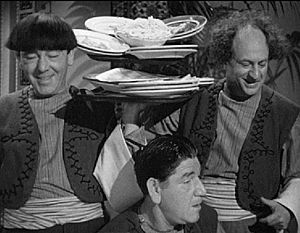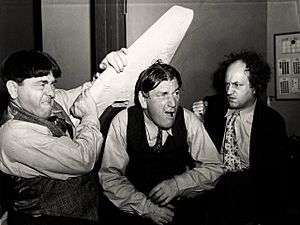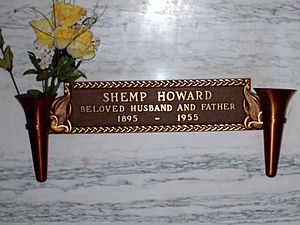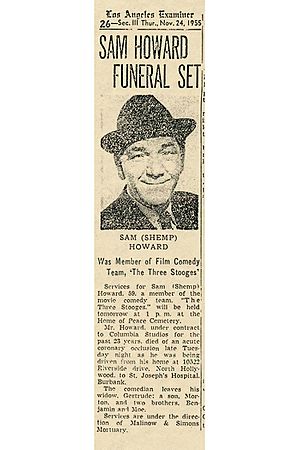Shemp Howard facts for kids
Quick facts for kids
Shemp Howard
|
|
|---|---|
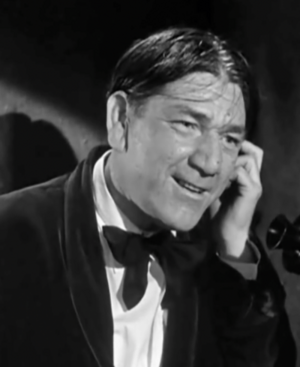
Howard in Brideless Groom (1947)
|
|
| Born |
Samuel Horwitz
March 11, 1895 Brooklyn, New York, U.S.
|
| Died | November 22, 1955 (aged 60) Los Angeles, California, U.S.
|
| Resting place | Home of Peace Cemetery |
| Occupation |
|
| Years active | 1923–1955 |
| Known for | The Three Stooges |
| Spouse(s) |
Gertrude Frank
(m. 1925) |
| Children | 1 |
| Relatives | Moe Howard (brother) Curly Howard (brother) Joan Howard Maurer (niece) |
Samuel Horwitz (born March 11, 1895 – died November 22, 1955) was an American comedian and actor. He was much better known by his stage name, Shemp Howard. People called him "Shemp" because his mother, who had a strong accent, said "Sam" in a way that sounded like "Shemp."
Shemp Howard is most famous for being the third member of The Three Stooges. He was part of the group when it first started in the early 1920s (from 1923 to 1932). Back then, the group worked with Ted Healy and was called "Ted Healy and his Stooges." Shemp returned to the Stooges in 1946 and stayed with them until he passed away in 1955. For 14 years between his times with the Stooges, he had a very successful career as a solo comedian in films. He came back to the Stooges to help his brother Moe and friend Larry Fine after his younger brother Curly became ill.
Contents
Early Life of Shemp Howard
Shemp Howard was born Samuel Horwitz on March 17, 1895, in Bensonhurst, a neighborhood in Brooklyn, New York. He grew up there with his family. He was the third of five brothers born to Solomon and Jennie Horwitz, who were Lithuanian Jewish immigrants. His older brothers were Irving and Benjamin (Jack). His younger brothers were Moses (Moe) and Jerome (Curly).
Shemp's first name, Shmuel, was changed to Samuel in English. His family and friends usually called him Sam.
Shemp Howard's Career in Entertainment
Starting in Show Business
Shemp's brother Moe Howard began performing at a young age in plays and movies. Later, Moe and Shemp created a comedy act together. They also worked on a different vaudeville stage without makeup.
By 1922, Moe had teamed up with his childhood friend Ted Healy, who was a vaudeville star. One day, Moe saw Shemp in the audience and called out to him from the stage. Shemp quickly called back and walked onto the stage. From that moment on, he became part of their act, which was usually known as "Ted Healy and His Stooges." The Howard brothers, Moe and Shemp, were the first Stooges. Larry Fine joined them in 1928. During their shows, Healy would sing and tell jokes while his three noisy stooges caused funny chaos. Shemp played a clumsy fireman in the Stooges' first movie, Soup to Nuts (1930). This was the only film where he was part of Healy's main group.
In August 1930, Moe, Larry, and Shemp decided to leave Healy and start their own act called "Howard, Fine & Howard." They performed on the RKO vaudeville circuit. They added "Three Lost Soles" to their act's name in 1931. Moe, Larry, and Shemp continued performing until July 1932. Then, Ted Healy asked them to join him again for a Broadway show called "Passing Show of 1932," and they agreed. Even though they had disagreements before, Moe knew that working with the famous Healy would give them more opportunities.
However, Shemp left Healy's act again in August 1932 because he was tired of Healy trying to control their careers. Shemp stayed with "Passing Show," which soon closed. Shemp then formed his own act and performed on the road for a few months. In May 1933, he found work at Vitaphone Studios in Brooklyn, where he could appear in movies. When Shemp left Healy, his younger brother Jerry Howard (Curly) quickly took his place.
Shemp's Solo Years
Like many performers in New York, Shemp Howard found work at the Vitaphone studio in Brooklyn. He started with small parts in comedies and quickly got bigger roles. He worked with other comedians and eventually starred in his own short comedies. One of his shorts, Art Trouble (1934), even featured a young James Stewart in his very first movie role. In a rare serious role, Shemp played a blackmailer in the movie Convention Girl (1935).
Shemp often didn't stick to the script. He made scenes funnier by adding his own lines and jokes, which became his special style. In 1935, Vitaphone started making short comedies based on the "Joe Palooka" comic strip. Shemp played "Knobby Walsh." Even though it was a supporting role, he became the main funny part of the series.
Shemp also tried to lead his own group of "stooges" in a musical comedy short, but it wasn't successful. In 1937, he moved to the West Coast, like his brothers, and got supporting roles at different studios, especially Columbia Pictures and Universal. He worked only at Universal from 1940 to 1943. He performed with famous comedians like W. C. Fields in The Bank Dick (1940) and with comedy teams Abbott and Costello and Olsen and Johnson. He also added humor to detective movies like Charlie Chan and The Thin Man series. Shemp appeared in several musical films in the early 1940s, often using his talent for making things up on the spot. He also played some serious parts, like in Pittsburgh (1942) with Marlene Dietrich and John Wayne.
The Three Stooges: 1946–1955
Between 1938 and 1946, Shemp appeared in Columbia's short comedies, working with other regular actors. He even got his own starring series in 1944. He was working for Columbia when his brother Curly had a serious stroke on May 6, 1946. Curly had been sick for a while, and Shemp had already filled in for him at a show in New Orleans in 1945.
Shemp agreed to take Curly's place in Columbia's popular Stooge shorts. He knew that if he said no, Moe and Larry would lose their jobs. He only planned to stay until Curly got better, but Curly's health continued to get worse. Curly passed away on January 18, 1952, at age 48. Shemp then agreed to stay with the group permanently.
Shemp's style as the third Stooge was different from Curly's. Curly was very energetic and acted like a big kid. Shemp was more of a relaxed, slightly silly character. While Curly had many unique actions, Shemp's most famous sound as a Stooge was a high-pitched "bee-bee-bee-bee-bee-bee!" sound. He made this sound when he was scared, sleeping (like snoring), very happy, or confused. It became his special sound, just like Curly's "nyuk nyuk" sound. Because Shemp had a successful solo career, he was also given chances in the films to do some of his own funny routines.
During this time, The Three Stooges also started appearing on live television. Their first TV show was on October 19, 1948, with Milton Berle on his Texaco Star Theatre program.
Shemp appeared with Moe and Larry in 73 short films. They also made one full-length movie, Gold Raiders (1951). Shemp had a mild stroke in November 1952 but recovered quickly. This health issue didn't noticeably affect his later films with the Stooges. Many of these later films were remakes of older ones and used recycled footage to save money.
Shemp Howard's Personal Life
In September 1925, Shemp married Gertrude Frank (1905–1982), who was also from New York. They had one child, a son named Morton (1927–1972).
Shemp often used his somewhat ordinary looks for comedy, making funny faces or letting his hair get messy. He even joked along with a publicity stunt that called him "The Ugliest Man in Hollywood." He was known to have many fears, including airplanes, automobiles, dogs, and water. According to Moe's autobiography, Shemp was in a driving accident as a teenager and never got a driver's license.
Death of Shemp Howard
On November 22, 1955, Shemp went to a boxing match with his friends Al Winston and Bobby Silverman. Boxing was one of Shemp's favorite hobbies. While riding home in a taxi that evening, Shemp died of a sudden heart attack. He was 60 years old.
Some books say he died on November 23, 1955, but the official death certificate from Los Angeles County states that Shemp Howard died on Tuesday, November 22, 1955, at 11:35 PM. His obituary also appeared in Los Angeles newspapers on the afternoon of November 23, confirming his death on the night of November 22.
Shemp Howard was buried in a crypt inside the mausoleum at the Home of Peace Cemetery in East Los Angeles. His younger brother Curly is also buried there, as well as his parents and older brother Benjamin "Jack."
Tributes to The Three Stooges
The Three Stooges received a star on the Hollywood Walk of Fame at 1560 Vine Street on August 30, 1983. This honored their contributions to entertainment.
The "Fake Shemps" and Their Legacy
Columbia Pictures had promised to release eight Three Stooges comedies in 1956. However, only four were finished when Shemp Howard passed away. To keep their promise, producer Jules White created four more shorts by using old film clips of Shemp. He then filmed new scenes with a body double, Joe Palma, who was a longtime supporting actor for the Stooges. Palma was mostly filmed from behind so viewers wouldn't see his face clearly.
Stooge fans later called Palma and other body doubles "Fake Shemps." This term was even used by director Sam Raimi and actor Bruce Campbell to describe stand-ins in other movies.
These re-edited films varied in quality. Some were cleverly put together, while others clearly showed where the old footage was patched in. For example, Rumpus in the Harem used parts from Malice in the Palace. Hot Stuff used clips from Fuelin' Around. And Commotion on the Ocean used parts from Dunked in the Deep. All the original films were released in 1949, and the re-edited ones in 1956. The best-made "Fake Shemp" film was Scheming Schemers (1956), which combined new footage with clips from three old Stooge shorts: A Plumbing We Will Go (1940), Half-Wits Holiday (1947), and Vagabond Loafers (1949).
When it was time to renew the Stooges' contract, Columbia hired comedian Joe Besser to replace Shemp. Columbia stopped making new Stooge short comedies in December 1957. The last new short was released in June 1959. However, the series continued into the 1960s because Shemp's Stooge shorts were re-released in theaters and shown on TV. This helped Shemp Howard remain a popular star long after his death.
In the 2000 TV movie The Three Stooges, actor John Kassir played Shemp Howard.
Selected Filmography (Non-Stooge)
- Features
- Soup to Nuts (1930)
- Convention Girl (1935)
- Hollywood Round-Up (1937)
- Headin' East (1937)
- Behind Prison Gates (1939)
- Another Thin Man (1939)
- The Lone Wolf Meets a Lady (1939)
- The Leather Pushers (1939)
- Give Us Wings (1939)
- The Bank Dick (1939)
- Murder Over New York (1939)
- Millionaires in Prison (1940)
- The Invisible Woman (1940)
- Six Lessons from Madame La Zonga (1941)
- Buck Privates (1941)
- Hold That Ghost (1941)
- Meet the Chump (1941)
- Road Show (1941)
- Mr. Dynamite (1941)
- The Flame of New Orleans (1941)
- Too Many Blondes (1941)
- In the Navy (1941)
- Tight Shoes (1941)
- San Antonio Rose (1941)
- Hit the Road (1941)
- Cracked Nuts (1941)
- Hellzapoppin' (1941)
- Butch Minds the Baby (1942)
- The Strange Case of Doctor Rx (1942)
- Mississippi Gambler (1942)
- Private Buckaroo (1942)
- Strictly in the Groove (1942)
- Arabian Nights (1942)
- How's About It (1942)
- Pittsburgh (1942)
- Keep 'Em Slugging (1943)
- Crazy House (1943)
- Three of a Kind (1943)
- Moonlight and Cactus (1943)
- Strange Affair (1944)
- Crazy Knights (1944)
- Trouble Chasers (1945)
- The Gentleman Misbehaves (1946)
- One Exciting Week (1946)
- Dangerous Business (1946)
- Blondie Knows Best (1946)
- Africa Screams (1949)
- Gold Raiders (1951)
- Two Reelers
- Salt Water Daffy (1933)
- Close Relations (1933)
- Paul Revere, Jr. (1933)
- Gobs Of Fun (1933)
- In The Dough (1933)
- Here Comes Flossie! (1934)
- Howd' Ya Like That? (1934)
- Henry The Ache (1934)
- The Wrong, Wrong Trail (1934)
- Mushrooms (1934)
- The Knife Of The Party (1934)
- Everybody Likes Music (1934)
- Pugs and Kisses (1934)
- Very Close Veins (1934)
- Pure Feud (1934)
- Corn On The Cop (1934)
- I Scream (1934)
- Rambling 'Round Radio Row # 7 (Series 2 # 1) (1934)
- Art Trouble (1934)
- My Mummy's Arms (1934)
- Daredevil O'Dare (1934)
- Smoked Hams (1934)
- So You Won't T-T-T-Talk (1934)
- Dizzy & Daffy (1934)
- A Peach Of A Pair, (1934)
- His First Flame (1935)
- Convention Girl (1935)
- Why Pay Rent? (1935)
- Serves You Right (1935)
- On The Wagon (1935)
- The Officer's Mess (1935)
- While The Cat's Away (1936)
- For The Love Of Pete (1936)
- Absorbing Junior (1936)
- Here's Howe (1936)
- Punch And Beauty (1936)
- The Choke's On You (1936)
- The Blonde Bomber (1936)
- Kick Me Again (1937)
- Taking The Count (1937)
- Hollywood Round-Up (1937)
- Headin' East (1937)
- The Leather Pushers (1938)
- Home On The Rage (1938)
- Behind Prison Gates (1939)
- Glove Slingers (1939)
- Money Squawks (1940)
- The Lone Wolf Meets A Lady (1940)
- Millionaires In Prison (1940)
- Pleased To Mitt You (1940)
- Pick A Peck Of Plumbers (1944)
- Open Season For Saps (1944)
- Off Again, On Again (1945)
- Where The Pest Begins (1945)
- A Hit With A Miss (1945)
- Mr. Noisy (1946)
- Jiggers, My Wife (1946)
- Society Mugs (1946)
- Bride And Gloom (1947)
- with The Three Stooges
- Fright Night (1947)
- Out West (1947)
- Hold That Lion! (1947) (His brother Curly Howard in a cameo)
- Brideless Groom (1947)
- Sing a Song of Six Pants (1947)
- All Gummed Up (1947)
- Shivering Sherlocks (1948)
- Pardon My Clutch (1948)
- Squareheads of the Round Table (1948)
- Fiddlers Three (1948)
- The Hot Scots (1948)
- Heavenly Daze (1948)
- I'm a Monkey's Uncle (1948)
- Mummy's Dummies (1948)
- Crime on Their Hands (1948)
- The Ghost Talks! (1949)
- Who Done It? (1949)
- Hokus Pokus (1949)
- Fuelin' Around (1949)
- Malice in the Palace (1949) (brother Curly Howard's second cameo as a Chef filmed but not used)
- Vagabond Loafers (1949)
- Dunked in the Deep (1949)
- Punchy Cowpunchers (1950)
- Hugs and Mugs (1950)
- Dopey Dicks (1950)
- Love at First Bite (1950)
- Self-Made Maids (1950)
- Three Hams on Rye (1950)
- Studio Stoops (1950)
- Slaphappy Sleuths (1950)
- A Snitch in Time (1950)
- Three Arabian Nuts (1951)
- Baby Sitters Jitters (1951)
- Don't Throw That Knife (1951)
- Scrambled Brains (1951)
- Merry Mavericks (1951)
- The Tooth Will Out (1951)
- Hula-La-La (1951)
- Pest Man Wins (1951)
- A Missed Fortune (1952)
- Listen, Judge (1952)
- Corny Casanovas (1952)
- He Cooked His Goose (1952)
- Gents in a Jam (1952)
- Three Dark Horses (1952)
- Cuckoo on a Choo Choo (1952)
- Up in Daisy's Penthouse (1953)
- Booty and the Beast (1953)
- Loose Loot (1953)
- Tricky Dicks (1953)
- Spooks! (1953) (first flat widescreen short)
- Pardon My Backfire (1953)
- Rip, Sew and Stitch (1953)
- Bubble Trouble (1953)
- Goof on the Roof (1953)
- Income Tax Sappy (1954)
- Musty Musketeers (1954)
- Pals and Gals (1954)
- Knutzy Knights (1954)
- Shot in the Frontier (1954)
- Scotched in Scotland (1954)
- Fling in the Ring (1955)
- Of Cash and Hash (1955)
- Bedlam in Paradise (1955)
- Stone Age Romeos (1955)
- Wham-Bam-Slam! (1955)
- Hot Ice (1955)
- Blunder Boys (1955)
- Husbands Beware (1956)
- Creeps (1956)
- Flagpole Jitters (1956)
- For Crimin' Out Loud (1956)
- Rumpus in the Harem (1956) (“Fake Shemp”; filmed after his death)
- Hot Stuff (1956) (“Fake Shemp”; filmed after his death)
- Scheming Schemers (1956) (“Fake Shemp”; filmed after his death)
- Commotion on the Ocean (1956) (“Fake Shemp”; filmed after his death)
See also
 In Spanish: Shemp Howard para niños
In Spanish: Shemp Howard para niños


